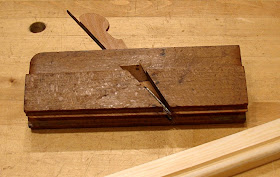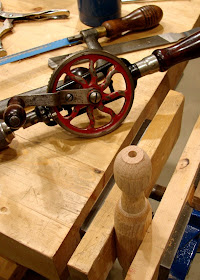The other day I successfully replaced a broken wedge on a side bead moulding plane that I bought on eBay. This was an almost "perfect" project. What made it special was a combination of many of the things I especially enjoy in a project: an old tool brought back to life, using shop-made equipment (successfully), finding a suitable job for a special stash of wood, applying my developing skills to overcome a lingering mental block, and a full and complete project in under two hours. That's a rare single project combination in my shop!
I'd had this plane for a while, but had not been able to use it because the wedge that holds the iron had broken off the very first time I tried to remove it (and yes there is an embarrassing story there, and no, I'm not going to tell it now). I successfully removed the remainder of the jammed wedge from the plane by turning it upside down, clamping the stump of the wedge in the bench vise and lifting the plane body off of it. But that is when the mental block came into play. For some reason I was intimidated by the idea of making a replacement wedge. I'm not sure why, but I convinced myself that this would be a hard thing to do. Stupid. And so this poor plane had been languishing on my desk; the island of misfit tools.
Here's a shot of the original wedge:

The first step was to prepare some stock. I was going to use some oak, when I remembered that my good friend Dave had sent me some hunks of salvaged beech wood, which would be much more appropriate. Thanks again Dave! After cutting a piece and resawing it to approximate thickness, I planed it to final thickness by working against one of my bench dogs. This is a handy trick for thin stock. I also traced the outline of the original wedge (after piecing it back together) on the new blank.

Taking it over to my saw bench, I used the slot in the overhanging end as a birdsmouth and cut out the shape of the wedge and finial with a coping saw.

To ensure that the straight edges of the wedge were true, I used a plane. It's difficult to secure small pieces and accurately plane them, so in this case I found it much easier to hold the plane in the vise and push or pull the wedge along the plane. Kind of like a miniature power jointer - only without the power :)

I cleaned up the finial curves with a file, and after some trial and error adjustments to the wedge angle, I had what looked and felt like a good fit. But there was only one way to be sure. A quick trip to the Scary Sharp bench, and the ca. 1850 Winsted plane was ready for a test drive on the sticking board; it worked great!

And here's a final shot of the now happy plane, ready to join its brethren on the shelves:



























